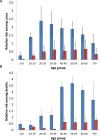Global Morbidity and Mortality of Leptospirosis: A Systematic Review
- PMID: 26379143
- PMCID: PMC4574773
- DOI: 10.1371/journal.pntd.0003898
Global Morbidity and Mortality of Leptospirosis: A Systematic Review
Abstract
Background: Leptospirosis, a spirochaetal zoonosis, occurs in diverse epidemiological settings and affects vulnerable populations, such as rural subsistence farmers and urban slum dwellers. Although leptospirosis is a life-threatening disease and recognized as an important cause of pulmonary haemorrhage syndrome, the lack of global estimates for morbidity and mortality has contributed to its neglected disease status.
Methodology/principal findings: We conducted a systematic review of published morbidity and mortality studies and databases to extract information on disease incidence and case fatality ratios. Linear regression and Monte Carlo modelling were used to obtain age and gender-adjusted estimates of disease morbidity for countries and Global Burden of Disease (GBD) and WHO regions. We estimated mortality using models that incorporated age and gender-adjusted disease morbidity and case fatality ratios. The review identified 80 studies on disease incidence from 34 countries that met quality criteria. In certain regions, such as Africa, few quality assured studies were identified. The regression model, which incorporated country-specific variables of population structure, life expectancy at birth, distance from the equator, tropical island, and urbanization, accounted for a significant proportion (R(2) = 0.60) of the variation in observed disease incidence. We estimate that there were annually 1.03 million cases (95% CI 434,000-1,750,000) and 58,900 deaths (95% CI 23,800-95,900) due to leptospirosis worldwide. A large proportion of cases (48%, 95% CI 40-61%) and deaths (42%, 95% CI 34-53%) were estimated to occur in adult males with age of 20-49 years. Highest estimates of disease morbidity and mortality were observed in GBD regions of South and Southeast Asia, Oceania, Caribbean, Andean, Central, and Tropical Latin America, and East Sub-Saharan Africa.
Conclusions/significance: Leptospirosis is among the leading zoonotic causes of morbidity worldwide and accounts for numbers of deaths, which approach or exceed those for other causes of haemorrhagic fever. Highest morbidity and mortality were estimated to occur in resource-poor countries, which include regions where the burden of leptospirosis has been underappreciated.
Conflict of interest statement
The authors have declared that no competing interests exist.
Figures




Comment in
-
Leptospirosis: Updating the Global Picture of an Emerging Neglected Disease.PLoS Negl Trop Dis. 2015 Sep 24;9(9):e0004039. doi: 10.1371/journal.pntd.0004039. eCollection 2015 Sep. PLoS Negl Trop Dis. 2015. PMID: 26402855 Free PMC article. No abstract available.
References
-
- Bharti AR, Nally JE, Ricaldi JN, Matthias MA, Diaz MM, et al. Leptospirosis: a zoonotic disease of global importance. Lancet Infect Dis. 2003; 3: 757–771. - PubMed
-
- de Vries SG, Visser BJ, Nagel IM, Goris MG, Hartskeerl RA, et al. Leptospirosis in Sub-Saharan Africa: a systematic review. Int J Infect Dis. 2014; 28: e47201e64. - PubMed
Publication types
MeSH terms
Grants and funding
LinkOut - more resources
Full Text Sources
Other Literature Sources
Medical
Miscellaneous

